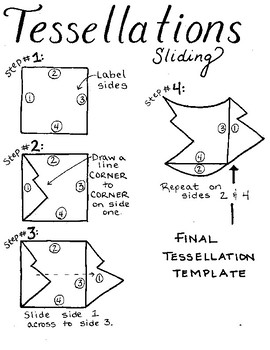


Now swap the NE with the SW corners and swap the NW and SE pair. Lay the pieces out on the table just as they were before cutting, except leave a little gap in between.

Now when the kids go back to finish the first line (starting exactly where they left off) we know they will get an accurate cut.

Start cutting either line and cut to just past the point where it intersects the other line and stop.Here are some other word combinations that work: PETS/STEP, POTS/STOP, EVIL/LIVE or FLOG/GOLF, BRAG/GARB or TRAM/MART, TIME/EMIT, PANS/SNAP, or RATS/STAR. In step 3, rearrange the PARTs with the letters at the CENTER, so they spell TRAP. Note from the webmaster: It may make more sense to you if you label the outside corners PART. Before cutting out the drawn lines we write NW in the northwest corner, SW in the southwest corner, NE in the northeast corner and SE in the southeast corner.Step #1 and #3 are to get the tessera to tessellate. I finally added some little refinements which make it work nearly every time. "The tessellation method from your site which I tried to use with my 3 rd graders was Rachel's 'Papercut Method' but I had a lot of trouble getting it to work. You can also see this tessellation lesson adapted for Microsoft Windows' "Paint" program and any digital painting program.Īrt and Math teacher Jan Miller has this to add, based on using Rachael's tutorial in her classroom: We salute Rachael's effort and desire to help others. It came to us from 15-year-old Guest Artist Rachael G*. This particular tessellation tutorial is also a landmark: our first tessellation lesson sent to us by a guest artist, years ago. This tessellation lesson is easy and foolproof.
MAKING TESSELLATIONS HOW TO
How to Make an Asian Chop (stone stamp).Generate Tessellations performs the function of the Generate Tessellation geoprocessing tool. If you are trying to aggregate points or summarize features in a tessellated grid, Aggregate Points and Summarize Within have built-in options to create tessellations. Other tools may be useful in solving similar but slightly different Use Generate Tessellations to create tessellations determined by a specified extent, shape, and size. These distortions are part of the display only and do not The result is projected to Web Mercator forĭisplay (the default) or to the projection of your custom basemap.Ī Web Mercator projection may cause your results to appearĭistorted, especially for large bins or bins near the polar Projection and parameters are chosen based on the specified geographic extent. Specified size dimensions to ensure that the sizes are equal andĪppropriate for the area of interest. In a custom, area-preserving projected coordinate system using the The distance is calculated as follows, where d is the value of the distance parameter: The size of each tessellation feature or bin can be calculated by specifying a value to represent the area for each bin in square units or by specifying a distance value. The letters in the IDs represent the columns and the numbers represent the rows, as shown in the following image: The format for the IDs is A-1, A-2, B-1, B-2, and so on. The GRID_ID field provides a unique ID for each feature in the output feature class. The output features contain a GRID_ID field. The extent of the tessellations that will be generated is determined by the Define Extent parameter, which can be the current map extent, the extent of an existing layer, or the extent of an interactively drawn study area. The Use current map extent parameter is unavailable for Generate Tessellations. To record each artifact, a grid of tessellated features is created to cover the entire study area to index and record the precise location of the artifacts. An archeologist has discovered an ancient burial ground that contains many valuable artifacts and historical treasures.When added to a map, the cartographer can symbolize the summarized data appropriately to convey the story. Using the Generate Tessellations tool, the cartographer can create regularly shaped areas into which the points can be aggregated and summarized. A cartographer has dense point-based data and wants to present the data in a map that is visually appealing and easily understood.
MAKING TESSELLATIONS FULL
Generate Tessellations can be used to automatically create a dataset of appropriately sized bins for the full study area.


 0 kommentar(er)
0 kommentar(er)
